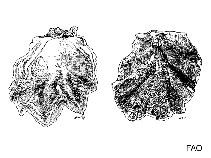Crassostrea tulipa (Lamarck, 1819)
West African mangrove oyster| Native range | All suitable habitat | Point map | Year 2050 |

|
| This map was computer-generated and has not yet been reviewed. |
| Crassostrea tulipa AquaMaps Data sources: GBIF OBIS |
Upload your photos
Google image | No image available for this species;
drawing shows typical species in Ostreidae.
Google image | No image available for this species;
drawing shows typical species in Ostreidae.
Classification / Names Populärnamn | synonymer | CoL | ITIS | WoRMS
Bivalvia | Ostreida | Ostreidae
Environment: milieu / climate zone / djupintervall / distribution range Ekologi
; brackvatten. Tropical; 23°C - 31°C (Ref. 112235); 21°N - 24°S, 61°W - 14°E (Ref. 111917)
Distribution Länder | FAO områden | Ekosystem | Förekomster | Utplanteringar
Atlantic Ocean: From Mauritania to Angola and from Venezuela to Brazil.
Length at first maturity / Size / Weight / Age
Könsmognad: Lm ? range ? - ? cm
Inhabits the intertidal zone of rivers and estuaries (Ref. 101380). Also in mangrove estuaries where it is often associated with the air roots of mangrove trees, coastal rocks and stones (Ref. 101381). Often seen attached to the stilt roots of the red mangrove Rhizophora spp., fringing lagoons and estuaries (Ref. 106421). Also found on low subtidal level attached to rocks, shells, or stones on muddy sand bottoms (Ref. 109255). Oyster assemblage confers protection and food for various invertebrates and fishes (Ref. 101381). Filter-feeder, feeds on phytoplankton (green algae, diatoms, dinoflagellates) and substrate particles (Ref. 106999).
Life cycle and mating behavior Könsmognad | Reproduktion | Lek | Eggs | Fecundity | Larvae
Members of the class Bivalvia are mostly gonochoric, some are protandric hermaphrodites. Life cycle: Embryos develop into free-swimming trocophore larvae, succeeded by the bivalve veliger, resembling a miniature clam.
Main reference
referenser | Koordinator | Medarbetare
Ranson, G. 1960. (Ref. 83479)
IUCN Red List Status
(Ref. 130435: Version 2024-2)
Least Concern (LC) ; Date assessed: 24 September 2019
CITES status (Ref. 108899)
Not Evaluated
CMS (Ref. 116361)
Not Evaluated
Threat to humans
Harmless
Human uses
Fiskeri: kommersiell
| FishSource | Sea Around Us
Verktyg
Ytterligare information
Trophic Ecology
Ekologi
Population dynamics
Tillväxt
Max. ages / sizes
Length-weight rel.
Length-length rel.
Length-frequencies
Mass conversion
Rekrytering
Abundans
Max. ages / sizes
Length-weight rel.
Length-length rel.
Length-frequencies
Mass conversion
Rekrytering
Abundans
Life cycle
Distribution
Human Related
Aquaculture profiles
Stamps, coins, misc.
Stamps, coins, misc.
Outreach
Taxonomy
referenser
Internet-källor
BHL | BOLD Systems | CISTI | DiscoverLife | FAO(Publication : search) | Fishipedia | GenBank (genome, nucleotide) | GloBI | Gomexsi | Google Books | Google Scholar | Google | PubMed | Tree of Life | Wikipedia (Go, sök) | Zoological Record
Estimates based on models
Price category
(Ref. 80766):
Unknown.
Nutrients : Calcium = 149 [71, 228] mg/100g; Iron = 8.53 [1.95, 15.11] mg/100g; Protein = 9.88 [8.64, 11.12] %; Omega3 = 0.313 [0.202, 0.423] g/100g; Selenium = 61 [50, 72] μg/100g; VitaminA = 0 μg/100g; Zinc = 2.04 [0.56, 3.51] mg/100g (wet weight); based on nutrient studies.



